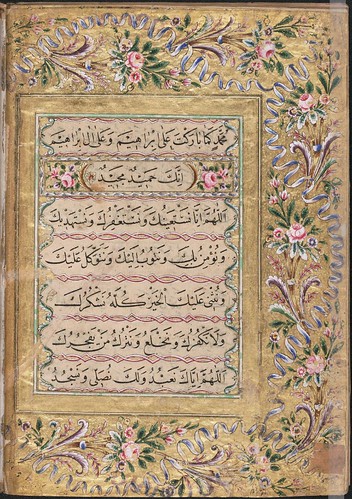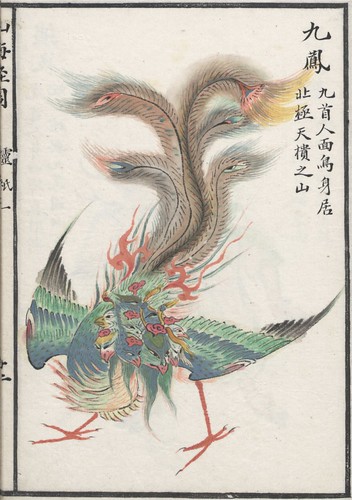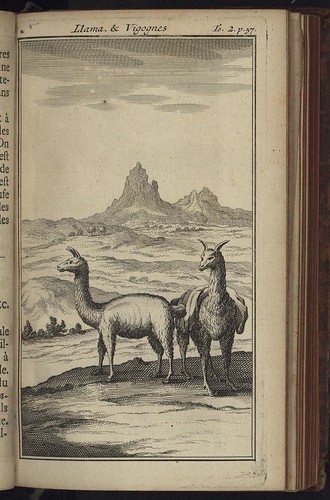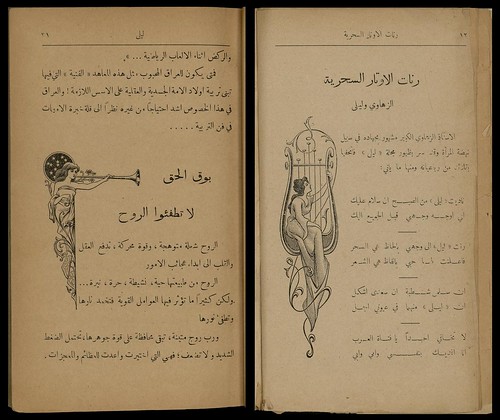'The Fencing Lesson' (1814)
"This original ink-and-watercolor caricature shows a petite, prancing Napoleon dueling with a heavy, domineering Gerhard Leberecht von Blücher, while a British sailor judges the match. The participants in the duel are backed by supporters: Napoleon’s faction includes French generals, while von Blücher’s includes German peasants and a Russian cossack. The caricature parodies political conditions at the time. Following Napoleon’s retreat from Russia, the Germanic states, led by Prussia, reentered the wars against Napoleon. At the time the caricature was made, Prussian incursions were the primary threat to France, and von Blücher was the field marshal who pressed to move the Prussian army into France itself. The work is by the Prussian artist Johann Gottfried Schadow (1764-1850)." [link]

IN: 'Description of Egypt: Natural History, Volume Two (Plates): Or, Collection of Observations and Research Conducted in Egypt During the Expedition of the French Army. Second Edition' (1826)
"When Napoleon Bonaparte invaded Egypt in 1798, he brought with him an entourage of more than 160 scholars and scientists. Known as the French Commission on the Sciences and Arts of Egypt, these experts undertook an extensive survey of the country’s archeology, topography, and natural history. [..] It proved so popular that a second edition was published under the post-Napoleonic Bourbon Restoration. The “Royal edition” (1821-29) from the collections of the Bibliotheca Alexandrina is presented here." [link]

IN: 'In Praise of the Most Serene Ferdinand, King of Spain, 'Baetic' and Ruler of Granada, Besieger, Victor, Triumphant: And On the Recently Discovered Islands in the Indian Sea' (1494)
"This book is a compilation of two texts, both relating to events in the momentous year of 1492. The first is a drama in Latin by an Italian author [..] [and] [t]he second text is Leandro di Cosco’s Latin translation of the letter by Christopher Columbus to Raphael Sánchez, in which Columbus recounted his voyage to America in 1492-93. Printed in Basel in 1494, it is one of six versions of the Columbus letter that were published in 1493-94, and the only one to include woodcut illustrations." [link]

Description of the Holy Land
"This woodcut map of 1585 shows the Holy Land as it would have appeared at the time of Jesus, divided into Galilee, Samaria, and Judea. The map appeared in the Itinerarium Sacrae Scripturae (Travel book through Holy Scripture) of Heinrich Bünting (1545-1606). [..] Itinerarium Sacrae Scripturae was an immensely popular book in its day. It provided the most complete available summary of biblical geography and described the geography of the Holy Land by tracing the travels of major figures from the Old and New testaments." [link]

Map of Mexico City
[cartographer: Antonio Alvarez; creator: Miguel Rivera]
[cartographer: Antonio Alvarez; creator: Miguel Rivera]
"Dated 1720, this map was produced by the government of Mexico City in order to improve urban sanitation through the collection of garbage. It shows the central part of the city in detail, including names of streets, plazas, hospitals, hospices, columns, small squares, arches, and other places." [link]

'Luxembourg, a Famous Fortress in the Duchy of the
Same Name in the Netherlands' [around 1730]
Same Name in the Netherlands' [around 1730]
"The city of Luxembourg, capital of the Grand Duchy of Luxembourg, is strategically located on a plateau above two gorges formed by the Alzette and Petrusse rivers. Already in the 4th century, it was the site of a Roman fort. In 963, Siegfried, Count of Ardennes and founder of the state of Luxembourg, built a castle on the same location. The walled town grew up around the castle, and the fortifications were strengthened over the course of centuries. This map, by Mattheus Seuter (1678-1756), shows both the fortifications and, in the inset at the bottom, a pictorial view of the city." [link]

Arabic primer of calligraphy [around 1852/1853]
"Muhammad Shafiq (died 1879) was a major Ottoman calligrapher who excelled in instructional calligraphic pieces. This particular work, filled throughout with intricate arabesque floral designs typical of the late Ottoman period, is in a notable Arabic calligraphic style, the naskhi script, which connects the Arabic letters to one another in a harmonious way." [link]

Nine-Headed Phoenix [17th to 20th century]
"This Qing-dynasty (1644-1911) print shows the nine-headed phoenix, a being from Chinese mythology with a bird's body and nine heads with human faces. It is one of several hybrid creatures mentioned in the Classic of Mountains and Seas (Shanhai jing), where it is said to dwell in the Great Wilds to the North at the mountain called Celestial-Coffer-at-the-Northern-Extremity. This entry is in what may be the most recent section of this work, which may have been composed at any time between the third or fourth century B.C. and the third or fourth century A.D." [link]

Chronicle of a Javanese Court in Yogyakarta [1800-1849]
"This illuminated page in Javanese script is from a chronicle of a Javanese court in Yogyakarta. Located in central Java, Yogyakarta was one of two main pre-colonial royal cities in Java and a center of Javanese culture. The history of local leaders and royal families was recorded in chronicles such as this one." [link]

Dharma Wonder Boy
"This early-18th century work by an unknown artist is a typical example of Nara-ehon, the illustrated manuscripts or hand-printed scrolls and books produced in Japan from the Muromachi (1333-1573) through the mid-Edo (1615-1868) periods. The Hōmyō dōji is originally an East Indian story with roots in Buddhism." [link]


The Constellations [1417]
"The astronomer ‘Abd al-Rahman ibn ‘Umar al-Sufi, commonly known as al-Sufi, was born in Persia (present-day Iran) in 903 A.D. and died in 986. He worked in Isfahan and in Baghdad, and is known for his translation from Greek into Arabic of the Almagest by the ancient astronomer Ptolemy. Al-Sufi’s most famous work is Kitab suwar al-kawakib (Book of the constellations of the fixed stars), which he published around 964. In this work, al-Sufi describes the 48 constellations that were established by Ptolemy and adds criticisms and corrections of his own." [link]


IN: 'Travels of Francois Coreal to the West Indies, Containing the Most Remarkable Things He has Seen on His Voyage from 1666 to 1697' [1722]
"This three-volume work by a Spanish author of uncertain identity, Francisco (François) Coreal, was published in Amsterdam in 1722. It purports to be the French translation of a first-hand account, in Spanish, of multiple voyages to Brazil and Spanish America undertaken by Coreal over a span of 30 years, from 1666-97. Coreal's supposed voyages cover about half of the three volumes. The rest of the work is comprised of a heterogeneous set of texts taken from the travelogues of Sir Walter Raleigh (1552-1618) and several of his contemporaries. Many scholars believe that Coreal was a fictitious name for a writer who may never have traveled to the lands described in the book." [link]

Layla, Issue 1, October 15, 1923
[from the National Library of Iraq]
[from the National Library of Iraq]
"Layla was the first women's magazine to be published in Iraq. Launched in 1923, the magazine dealt with new and useful matters related to science, art, literature, sociology, and in particular to child-rearing and the education of girls, family health, and other matters pertaining to home economics. The establishment of national rule in Iraq was followed by the emergence of several magazines and newspapers dealing with women's issues. Layla marked the beginnings of the women's press in Iraq, and the magazine is credited with being one of the factors in the emergence of the Arab women’s movement." [link]

'Australia has Promised Britain 50,000 More Men;
Will You Help Us Keep that Promise'
Will You Help Us Keep that Promise'
"In World War I, all sides used posters as tools to mobilize their populations for the war effort. Australia fought on the side of its “mother country,” Great Britain. Australian soldiers suffered heavy casualties in the Gallipoli campaign and in the trenches on the Western front. Casualties led to recruiting drives intended to attract new enlistments. This poster by an unidentified artist appeals to the strong sense of loyalty to Britain felt by the Australian people." [link]
This post is intended as a preview/reminder/announcement in relation to the official launch of the World Digital Library tomorrow (that is, 21st April, 2009). A fair amount of material is already accessible.
The project site has video of the intended complete functionality of the WDL and I'm fairly sure the film has been around for a year or more. The full whizz-bang operating flair promised in the film does not appear to be quite there yet. [recent announcements: Library of Congress; Guardian UK]
Nevertheless, the site has been really well organised and will provide an exemplary model in terms of presentation/exhibition web architecture. The collections of rare books, prints & photographs, maps, films, manuscripts and recordings can be accessed in multiple ways (and in multiple languages): by date, country, material type, topic and institution, and the associated metadata links allow for very easy browsing. The majority of images I saw are available for download in tagged image file format (.tif) {otherwise as jpegs} and can be viewed on the site in a great (non-flash) zooming interface. Fingers crossed there will be much more material available soon.




















12 comments :
The interface on the WDL site is fantastic, when properly fleshed out it should be a great resource.
Great post as ever!
Thanks.
If you like art, I highly recommend having a look at curator's sites: Art Inconnu and the new one, Mela Muter.
There is also Europeana http://www.europeana.eu/portal/using-europeana.html. I'm not sure if there is any connection between Europeana and the WDL. There is a lot of good French material particularly on Europeana.
Thank you for recommending the curator's sites. I enjoyed them (knew about 1/3 of the artists and works I suppose). I will be bookmarking :-)
Sounds exciting!
Great news, this is an amazing resource for vintage & history lovers. I like the interface and the way the information is managed, really usable. Thanks for sharing the info!
Greetings from Spain,
anna
Susan, Resource Shelf gives a good overview this week of the Europeana site. I remember it had a very rocky beginning a few months ago (traffic brought it down I think). I have not yet had a chance to look around much, but shall do somewhere along the line.
Thanks Peacay – another useful reference to bookmark :-)
A comment just deleted went as follows:
"berkey said...
this is an amazing resource for vintage & history lovers. I like the interface and the way the information is managed, really usable.Thank you for recommending the curator's sites"
[advertising link redacted]
Beautiful!
Azhar Masood
This is such an amazing blog! Thank you for sharing all these wonderful illustrations. The one that really caught my attention was the illustration of the octopus. Do you perhaps know of any illustrations of an octopus used as body art? Just wondering.
Thanks. It never fails to amaze me (I guess it shouldn't really) how many enquiries about tattoo art I get in emails. But I'm afraid I'd be no help with this, you're best off scouting around tattoo forums/blogs. I would think there will be many examples around. But you could do worse than starting here.
Thanks for the worth references, i found the Javanese chronicle here.
Post a Comment
Comments are all moderated so don't waste your time spamming: they will never show up.
If you include ANY links that aren't pertinent to the blog post or discussion they will be deleted and a rash will break out in your underwear.
Also: please play the ball and not the person.
Note: only a member of this blog may post a comment.